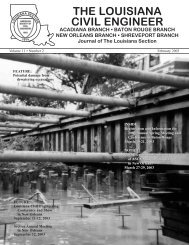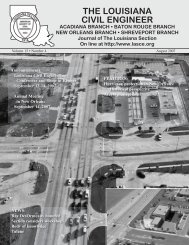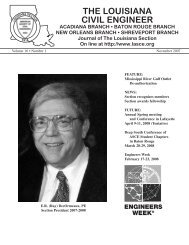THE LOUISIANA CIVIL ENGINEER - lasce
THE LOUISIANA CIVIL ENGINEER - lasce
THE LOUISIANA CIVIL ENGINEER - lasce
Create successful ePaper yourself
Turn your PDF publications into a flip-book with our unique Google optimized e-Paper software.
stream for a stream and not a wetland for a<br />
stream.<br />
Stormwater BMPs not enough<br />
In recent years, industry standards in the<br />
industrial and construction sectors have attempted<br />
with admirable success to address their hydromodification<br />
problems through the improvement<br />
and implementation of Best Management<br />
Practices (BMPs) as required by the CWA.<br />
Unfortunately, these measures, such as silt<br />
fences, detention/retention ponds, hydromulching<br />
and sodding, serve only to mitigate<br />
their individual, future impact on the watershed<br />
and they are external to the receiving channels.<br />
Applied only to the drainage basins, they do not<br />
directly address the regulated receiving conveyance<br />
channels such as ditches, streams, and<br />
rivers that are the water resource foundations of<br />
our communities.<br />
The science of fluvial geomorphology helps<br />
us to understand the natural response of our<br />
receiving conveyance channels to the dramatic<br />
watershed hydromodifications experienced since<br />
early in the 20th century. The channels altered<br />
their forms, most commonly through erosion and<br />
sedimentation, in an attempt to accommodate<br />
their new hydrologic conditions. Unfortunately,<br />
this natural process of transition to a new state of<br />
equilibrium occurs much slower than the rate of<br />
watershed hydromodification to which they have<br />
been subjected. As a result, virtually all of our<br />
receiving conveyance channels have been subjected<br />
to an almost continuous state of instability<br />
as they slowly respond to the rapidly changing<br />
conditions caused by watershed hydromodification.<br />
As a result they are subject to flash floods,<br />
high sediment and pollutant loads, highly incised<br />
(entrenched) channels, over-widened channels,<br />
unstable channel banks, and an inability to maintain<br />
vegetation.<br />
Our past attempts to address these issues<br />
through traditional hydraulic engineering practices<br />
as exhibited in Figures 10, 11, and 12, have<br />
only exacerbated the problem. Such<br />
channels/systems are designed using the simplest<br />
geometric forms without recognition of — and<br />
not in harmony with — basic fluvial geomorphological<br />
principles. Armoring engineered<br />
Figure 6. Typical hydrographs of a stable natural<br />
stream and an unstable urbanized channel.<br />
Figure 11. Armoring a channel with concrete<br />
liner to prevent erosion.<br />
channels with concrete liners does not eliminate<br />
the erosion/sedimentation problems, it just<br />
moves them downstream. As a result construction<br />
of new civil works often modifies the watershed<br />
and immediately places the conveying and<br />
receiving channels in a state of instability as the<br />
natural forces immediately begin their long<br />
process to re-establish stability or equilibrium as<br />
shown. The evolution to re-establish equilibrium<br />
invariably involves erosion and sedimentation,<br />
both of which are diametrically opposed to the<br />
intent of the original design to establish a stable<br />
channel configuration. This would appear to<br />
lead to the conclusion that NCD is the only<br />
means to effectively minimize or eliminate longterm<br />
channel instability.<br />
Approaches to NCD<br />
The advantages and disadvantages of natural<br />
channel design provided in the sidebar are usually<br />
intuitive to the engineer who has spent any<br />
time in the field observing both hydrodynamically<br />
stable and unstable channels. Figure 3<br />
schematically demonstrates the characteristics<br />
and components of a stable natural channel that<br />
are to be emulated in a NCD. When compared to<br />
the engineered channel, the disadvantages of<br />
NCD are the additional costs of the design<br />
process, and the additional right of way required<br />
to provide for the riparian floodplain and the<br />
inability to accommodate development such as<br />
housing in the riparian floodplain.<br />
The state-of-the-technology and -practice in<br />
NCD as described is in its infancy. As such, it is<br />
understandable that the evolving design methodologies<br />
in the field are far from any universally<br />
accepted standards. The debate concerning the<br />
value and validity of NCD is ongoing between<br />
the fluvial geomorphologists who have<br />
addressed the subject based on this new and validated<br />
science, and those who are educated<br />
exclusively in conventional hydraulic engineering.<br />
In the author’s mind, the knowledge and<br />
collaboration from both camps is critical to effectively<br />
merge the science and technology needed<br />
Figure 12. Storm sewers ostensibly alleviate<br />
all problems associated with channel instability<br />
by totally enclosing the flow.<br />
to expeditiously develop the practical ability to<br />
implement NCD on a large scale in Louisiana<br />
and across our nation.<br />
Hydrologist and fluvial morphologist Peter<br />
B. Skidmore recently provided a succinct<br />
description of the natural channel design protocols<br />
that are currently being employed.<br />
• The analog design approach replicates historic<br />
or nearby reference channel characteristics<br />
as shown in Figures 13 and 14, and<br />
assumes equilibrium between channel form<br />
(Continued on Page 26)<br />
Natural Channel Design Engineering<br />
Advantages are<br />
• a self-sustaining system that<br />
requires minimal maintenance —<br />
no net erosion or sedimentation<br />
• a tendency toward dynamic equilibrium<br />
that produces a multistage<br />
system capable of supporting<br />
healthy ecosystem during<br />
storm, normal and low flow events<br />
• a naturally formed flood plain that<br />
accommodates all storm waters<br />
— high energy and volume —<br />
during major storm events and<br />
prevents erosion of baseflow<br />
channels and flash conditions.<br />
• a riparian corridor buffer that<br />
maintains high water quality and<br />
• a baseflow channel able to support<br />
aquatic biota even during dry<br />
periods.<br />
Disadvantages are<br />
• complex design and construction<br />
• additional right of way required to<br />
accommodate flood plain and<br />
• development within the flood plain<br />
is not possible.<br />
<strong>THE</strong> <strong>LOUISIANA</strong> <strong>CIVIL</strong> <strong>ENGINEER</strong> / MAY 2006 25






